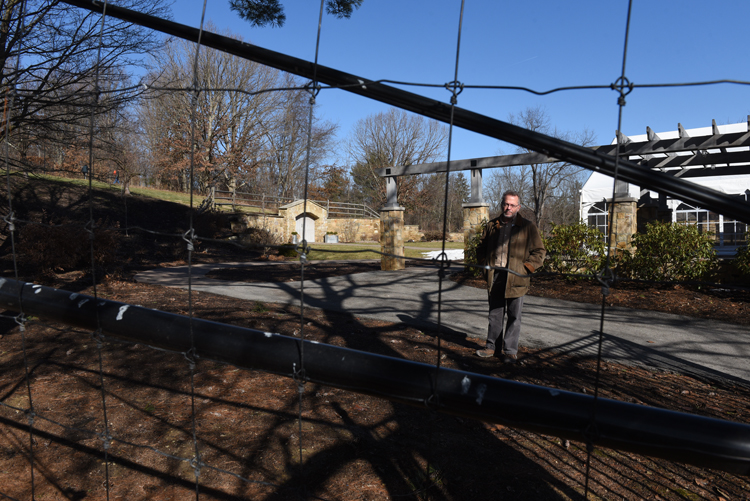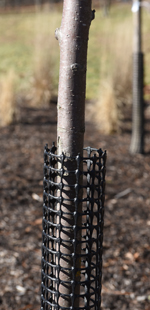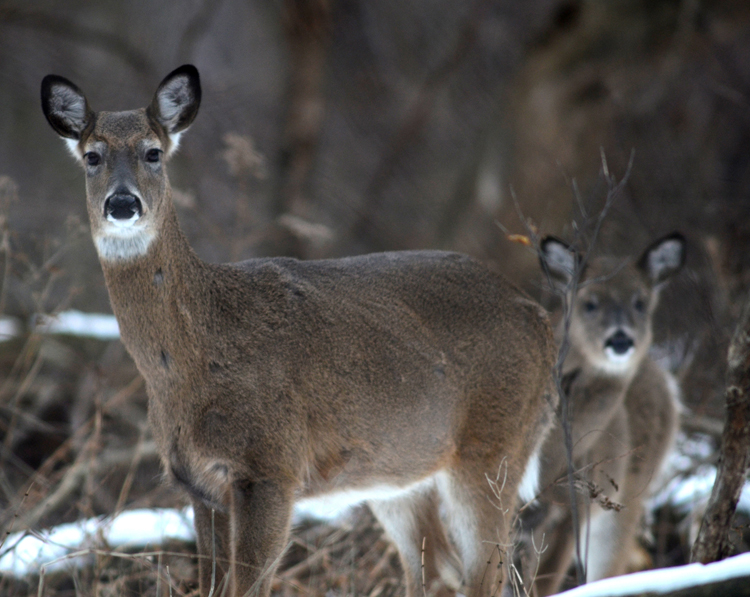Stopping deer in their tracks at the Pittsburgh Botanic Garden
Posted on: January 31, 2018 | Written By: Doug Oster |
While driving to work, Keith S. Kaiser hit a deer — again.
It’s the third one in the past 14 months he’s encountered with his vehicle, so it might not have been the best day to interview him about dealing with the four-legged pests in the garden.
“It’s worse than it’s ever been,” says the executive director of the Pittsburgh Botanic Garden in Oakdale. “In my early horticulture career of the late ’70s, you never heard about this. In a relatively short period of time, the population can explode.”

Keith S. Kaiser is the executive director of the Pittsburgh Botanic Garden. He stands in the Celebration Garden behind a fence that excludes the deer.

Many plants are individually protected with deer netting at the Pittsburgh Botanic Garden. This tree has the truck surrounded so that bucks will not rub it during the rut.
He has more than 400 acres to oversee, with 60 of them now open to the public. The Celebration Garden, right behind the Bayer Welcome Center, is surrounded by a tall fence and can be freely planted with anything Kaiser prefers. Using some kind of physical barrier is always the best way to keep them away from plants, he says.
Kaiser fantasizes about the entire space being fenced but the cost would be astronomical, just like it would be for most homeowners.
“The majority of our property has younger trees and shrubs that we’ve planted,” he says.
There have been thousands of plants added to the landscape along the miles of trails that wind through the garden. Any variety the deer would browse outside the enclosed area are individually fenced. Some plants have circular wire cages and others have wooden stakes surrounded with plastic deer netting.
In the Asian Woodland’s Japanese Garden overlooking the Lotus Pond is an unusual small tree that would be devoured by the deer. The Japanese Umbrella-pine (Sciadopity verticillata) is one that lives with the protection of the wire fencing.
In some cases, there are trees large enough that the deer can’t reach the buds and branches, but the trunks are vulnerable. During the fall and winter rut, bucks will rub the bark off to mark their territory. Those plants are fenced with something close to the trunk that has a texture the bucks don’t like. A huge stately Tanyosho pine (Pinus densiflora ‘Umbraculifera’) towers over the Lotus Pond with a fence below to prevent deer damage.
There are areas, though, that can’t be fenced, sometimes planted with seasonal annuals. In that case, his staff uses a deer repellent called Liquid Fence. There are a wide variety of liquid and granular products available at garden centers and nurseries, and all will help keep the deer away.
While Kaiser was out in the Dogwood Meadow speaking to visitors who were following him on a Winter Botany Walk and Talk, two small deer rambled along the woodland edge near the Dogwood Trail.
“I think those might be the twins from the spring,” Kaiser remarked to the crowd.
There are plenty of plants in the landscape that don’t need protection. There are evergreen hellebores, globular small inkberry shrubs, boxwoods and many others throughout the garden.
Some plants get trial by fire like the six-foot tall bay laurel shrubs right outside the Celebration Garden fence. They’re right in deer central and have a few nibbles, but it isn’t their favorite. “They don’t eat a lot plants with barbs (thorns) on them,” he says.
Roses, raspberries, barberry and even American holly are good choices. “They might eat the fruit, or young leaves,” he says, “but not the whole plant.”
On the other hand, Kaiser refers to tulips and hostas as deer candy.

Deer can be a real problem in the garden.
Part of dealing with these pests is determining for sure that it’s deer, not rabbits or groundhogs (during milder weather). Hoof prints are an obvious sign, as are the large pellets they leave, but sometimes a little more detective work is needed.
“Browse is typically defined as an angled cut which is kind of rough, it’s a ripped cut,” Kaiser says. Deer eat a lot and often leave just the stems.
This severe winter has made the deer pressure even more prevalent. Once the forest begins to green up, usually the deer aren’t as much as a problem. But they certainly have no fear of humans.
“Right outside the Welcome Center, I came up to about 10 feet away, I could have almost touched them,” Kaiser says with a chuckle.
It’s not just a problem for gardeners, as he can attest from his morning altercation with the deer; it’s a problem for everyone.
Doug Oster is editor of Everybody Gardens, a website operated by 535Media, LLC. Reach him at 412-965-3278 or doster@535mediallc.com. See other stories, videos, blogs, tips and more at everybodygardens.com.
More from Everybody Gardens